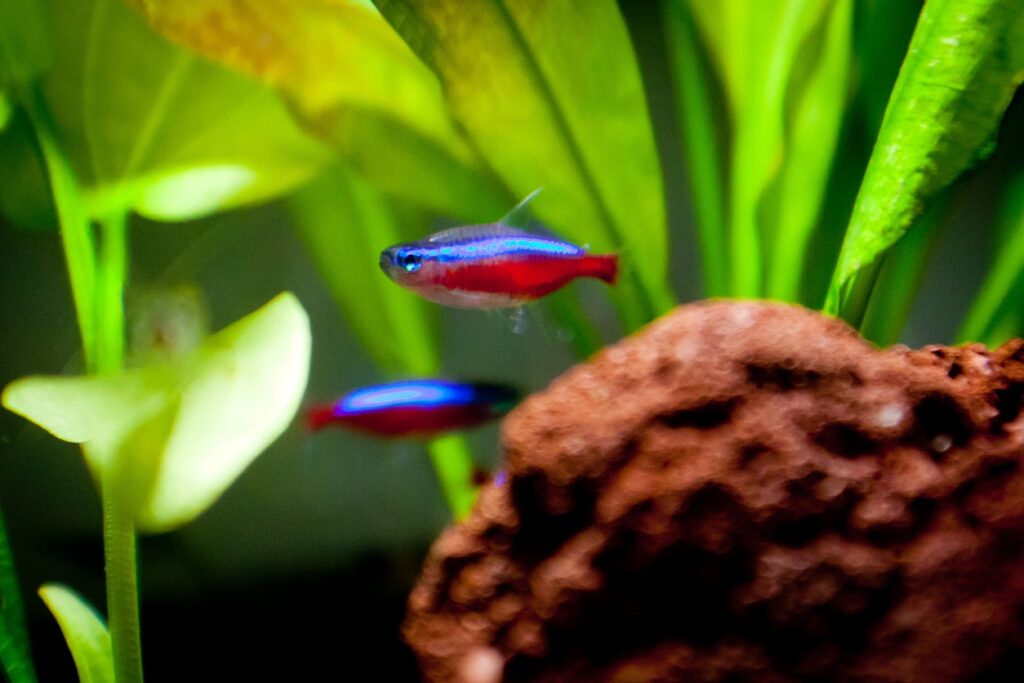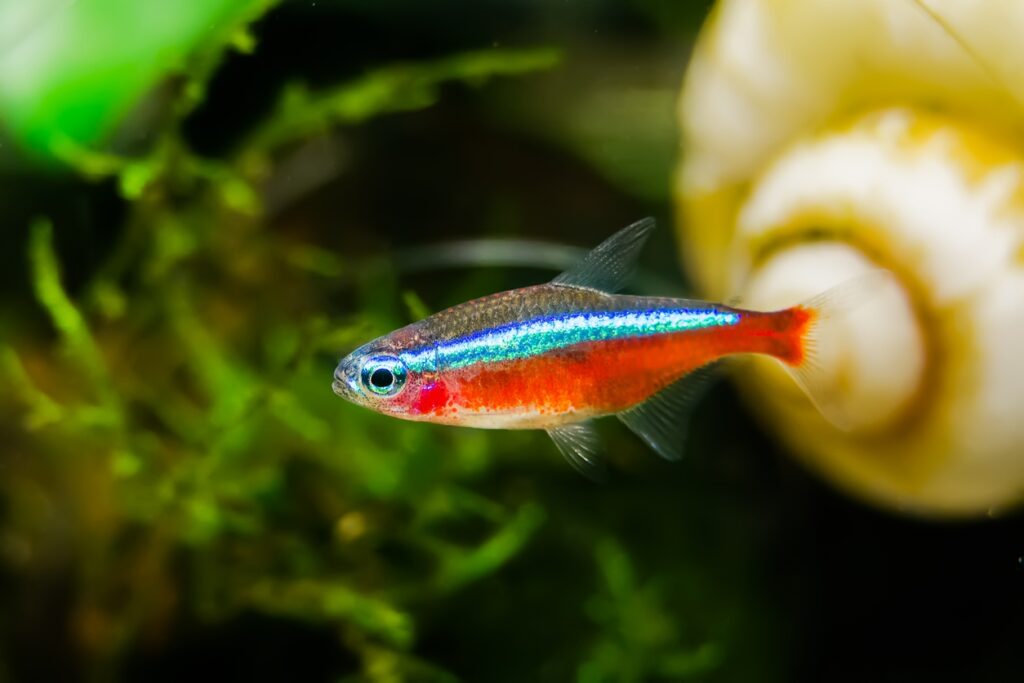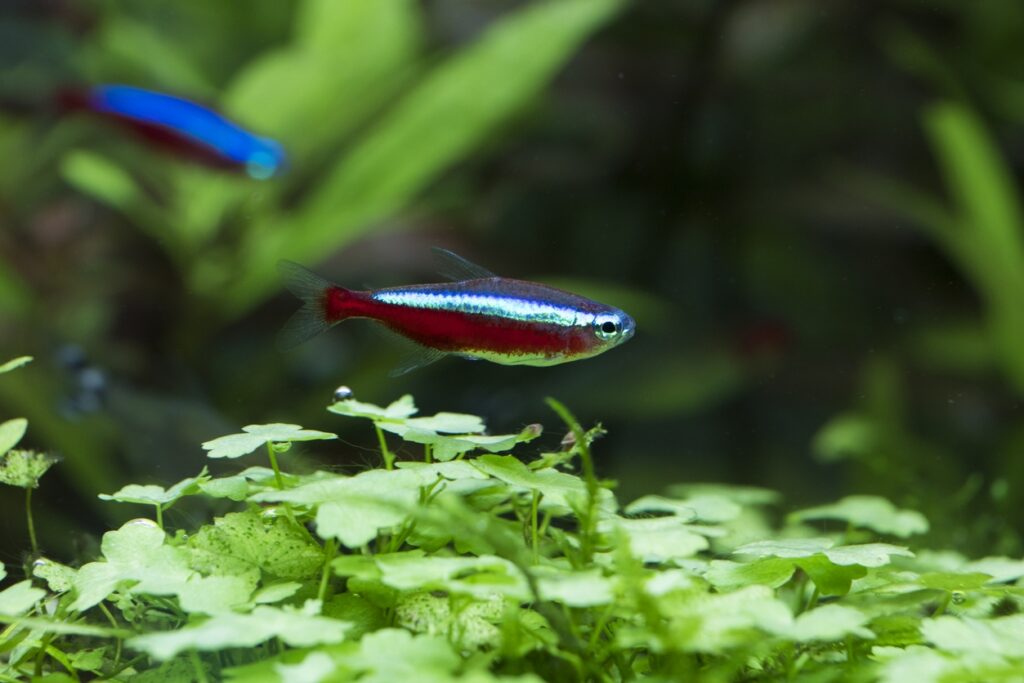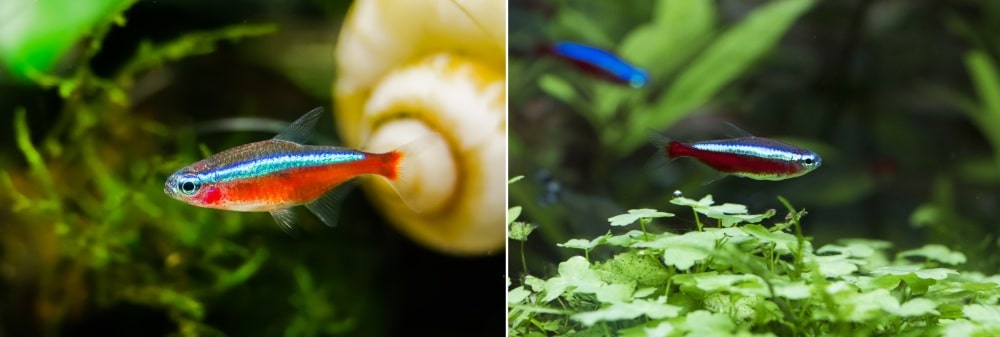If ever there were two fish that are immediately recognizable to most fish keepers, it’s likely these two! The Neon Tetra and Cardinal Tetra are fish that nearly every aquarist keeps at some point in their fishkeeping career. Beautiful, small, and peaceful, they have so much to offer!

But there is often confusion surrounding the differences between the two. They are close relatives, after all, so it’s only natural. What are the main similarities and differences between the Cardinal Tetra vs Neon Tetra?
Comparing the Neon and Cardinal Tetra
Neon Tetra

Of the two, the Neon Tetra is the easiest to care for. It is also smaller and a little less vibrant in red color compared to its larger cousin. But it’s still an aquarium classic for good reason!
Neon Tetra Size and Color
Neon Tetras (Paracheirodon innesi) are one of the most popular aquarium fish in the world and easily recognized! Their color scheme is striking, with a cherry red stripe running from the tip of their tail to their bellies.
From there, their bellies are silvery white. A bright blue iridescent stripe runs from their eye to the adipose fin. And their backs are a grey to greyish blue color, with clear, pointed fins!
They are on the smaller end of the scale for the Characin family. This massive family of fish ranges from even tinier tetras to the massive Black Pacu!
Neon Tetra Habitat
Neon Tetras are Amazonian natives that are found in both clearwater and blackwater habitats throughout the region (southeastern Colombia, western Brazil, and eastern Peru). They prefer blackwater conditions where the water is stained a tea-like color due to the plant tannins contained in it.
But they are also found in clear streams, so long as the water chemistry is acidic to slightly alkaline (pH 5.5-7.5). This tolerance for alkalinity is the main reason why Neon Tetras are much more popular than Cardinal Tetras, who tend to do poorly in alkaline conditions (pH 7.0+).
Feeding Neon Tetras
Like nearly all tetras, Neons are known as micro predators. This means that they feed on tiny animals for food! Small worms, baby fish, crustaceans like copepods and daphnia, insect larvae…Any small aquatic animals are fair game for them!
When feeding them in captivity Neon Tetras are very un-picky and will eat just about any flake or pellet formula you offer them! Just try to give them as much variety as you can and find sources of fresh animal protein to offer on occasion. Brine shrimp, blood worms, daphnia, tubifex, and other goodies are all easy to obtain, fresh or frozen, from your local pet store!
Breeding Neon Tetras
Neon Tetras aren’t the easiest of fish to breed, not compared to Guppies or Danios, but they aren’t too difficult to spawn. So long as you keep them in warm, clean conditions, offer plenty of fresh foods, and provide plants to deposit their eggs on, spawning will eventually happen.
Neon Tetras are egg scatterers, like nearly all tetras. Once the females and males embrace, they quickly forget about their eggs and fry though. Most Neon Tetra breeders use an egg mop; a tangle of artificial plants that the tetras will drop their eggs on and can then be removed. If you prefer a more natural approach, fine leaved plants like Guppy Grass and Java Moss are also ideal spawning spots for Neon Tetras!
Neon Tetra Color Morphs
There are a few color morphs available in the hobby but not nearly as many as other aquarium fish. Considering how long Neon Tetras have been around it’s possible they simply don’t have as much genetic variation to work with as other fish.
Gold Neon Tetras are the most common, followed by Albino and long-finned Neon Tetras. Sometimes aquarists mistake Green Neons and Black Neons as color morphs but they are actually different fish entirely; see below!
Cardinal Tetra

If you’re thoroughly in love with Neon Tetras then you can think of Cardinal Tetras (Paracheirodon axelrodi) as the next step up in difficulty! Being a little larger, a little harder to keep, and a little more expensive, they offer a very different experience for aquarists despite having the same basic color scheme!
Cardinal Tetra Size and Color
One of the most obvious differences between the Neon and Cardinal Tetra is how different they are in both size and color. While Neon Tetras are a fairly petite 1 to 1.5 inches long, 1.5 to 2 inches is more typical for Cardinals.
The Cardinal Tetra also has a red stripe that runs along the entire length of its body, from the tip of its tail all the way to the gill covers. This is the most obvious difference from the Neon Tetra, whose red stripe stops only halfway along its side. Both tetras do have an iridescent blue stripe that runs most of the length of their bodies.
Lastly the back of the Cardinal Tetra is a light to chocolate brown color rather than the steely blue-gray of the Neon Tetra!
Cardinal Tetra Habitat
Cardinal Tetras are almost never found side by side with Neon Tetras. Neon Tetras live throughout the Amazonian River basin. But Cardinal Tetras are found only in the upper Rio Negro and Orinoco River (which has a separate drainage basin from the Amazon).
Originally described by ichthyologist Leonard Peter Schultz, they were also known as Red Neon Tetras. After all, it was easy to see how similar they were to their close relatives.
While the air temperature is very high in these equatorial conditions, the water is often a few degrees cooler thanks to the shade provided by nearby jungle trees. The water temperature ranges from 78-82℉ (26-28℃) in areas where Cardinal Tetras tend to live.
The combination of decaying jungle debris, silica sand free of hardening minerals, and rainwater ensures the streams remain soft; i.e. low in hardness. Also, the pH is always on the acidic side, ranging from 5.5-6.5.
This demand for acidity is a major reason why beginners often fail to successfully keep Cardinal Tetras. They need both just to do well, let alone breed in captivity, unlike Neon Tetras, which have been tank bred for resistance to alkaline conditions.
Feeding Cardinal Tetras
Cardinal Tetras spend most of their time flitting in and around aquatic plants, looking for tiny invertebrates to eat. Just like Neon Tetras, they feed on worms, insect larvae, planktonic crustaceans like daphnia, and anything else that’s small and moving.
Since they are predators you should keep them on a high protein diet. When shopping for flake food, find brands that use mostly animal protein in the first few ingredients instead of potato starch, soy, corn, or other plant-based additives.
In addition to your high quality flakes or pellets you can offer fresh and frozen invertebrate-based foods like brine shrimp, bloodworms, tubifex, or daphnia! Their feeding habits are identical to those of Neon Tetras!
Breeding Cardinal Tetras
Another major difference between the two species is in how difficult it is to breed Cardinal Tetras. Neon Tetras aren’t exactly easy to breed but it’s also not impossible. But breeding Cardinal Tetras is a fairly rare occurrence.
The main issue is that the vast majority of Cardinal Tetras are wild-caught. They are acclimated to conditions that are just too different from what most home aquariums provide.
With no seasonal cues like water levels rising and falling from seasonal flooding, temperature shifts from the weather, and chemistry shifts as they’d experience in nature, it takes a lot of luck for your fish to synchronize their behavior and spawn.
That said, breeders in Southeast Asia are starting to have a lot of success with the difficult Cardinal Tetra. Many often use outdoor breeding ponds that allow fish to experience slight seasonal shifts to boost their success.
Like Neons, Cardinal Tetras are also egg scatterers. The parents provide no care besides ensuring the eggs are fairly well hidden. If you should succeed at breeding Cardinal Tetras you should remove either the parents or the eggs right away since the adults will eventually treat the eggs and fry as snacks to be eaten!
Cardinal Tetra Color Morphs
Cardinal Tetra color morphs are much rarer because these fish are not bred nearly as frequently as Neon Tetras are. The most common to find are albino Cardinal Tetras but other than that there really aren’t any color morphs available for this species. Expect that to change in the not-so distant future as more captive bred fish become available!
Cardinal and Neon Tetra Care

While they look very similar the two species do have some differences to consider. Something to remember is that Cardinal Tetras are almost exclusively wild-caught. That’s continuing to change and more captive-bred specimens are available than ever.
But the majority are still coming from international imports and thus are fairly fussy about water conditions compared to Neon Tetras. Cardinal Tetras are also less resistant to cold temperatures (below 72℉), to high levels of ammonia, nitrite, nitrate, and other problems that a Neon Tetra would ignore.
Both species do well when kept with other peaceful community fish around their size. Livebearers like Guppies, other Tetras, Apistogramma, German Blue Rams and other Dwarf Cichlids, Killifish, and the smaller Gourami species are all great choices!
You can also try keeping them with other South American natives like Discus and Angelfish, both of which also thrive in warm, soft, acidic water conditions. I recommend caution with Angelfish though, which are sometimes predatory once fully grown. They do get big enough to potentially eat young Neon Tetras if given the chance.
And just as an FYI, both Cardinal and Neon Tetras are susceptible to the dreaded Neon Tetra Disease. It is a parasitic infection that most tetras can catch. Since Neon Tetras are the most popular, the disease is named for them.
Live Plants with Neon and Cardinal Tetras
Live plants are also great to pair with Cardinal and Neon Tetras, in fact, I’d almost consider them essential for Cardinals! These fish love forming little territories and use plants to delineate the boundaries.
Live plants also provide cover, helping your schooling tetras feel secure enough to spend more time out in the open. Without plants tetras will often become much more shy and rarely move beyond what cover there is except to eat.
I recommend plants for Discus tanks and plants for Angelfish tanks. These plant species all favor the warm, acidic conditions that Neon and Cardinal Tetras also prefer!
What About Black Neon Tetras and Green Neon Tetras?
So if you’ve spent a little time wandering around your local fish store you may have come across these oddities as well! What about the Black Neon and Green Neon Tetra?
Even a casual glance will tell you that the Black Neon Tetra is a very different fish. Classified as Hyphessobrycon herbertaxelrodi, the Black Neon is only a distant relative. It has a brightly colored stripe to help schools of fish coordinate their movements in murky waters, just like the “classic” Neon and Cardinal Tetra do.
In fact, many popular tetras have a similar stripe, including the Glowlight Tetra (Hemigrammus erythrozonus) and the Emperor Tetra (Nematobrycon palmeri)! The Black Neon Tetra is a chunkier fish with a silver stripe and black sides whereas the classic Neon is blue with red. But just as easy to care for as the true Neon Tetra!
On the other hand, the Green Neon Tetra (Paracheirodon simulans) is a close relative of both the classic Neon and Cardinal Tetra. It is as long as a Neon Tetra but slimmer in profile. Since they are quite rare and always wild-caught, you’ll never confuse the two unless you mix them in the same tank.
You should never do this because they will interbreed with each other. True Green Neon Tetras are favorites of biotope and planted aquarium aquascapers due to their rarity so keep them separate from their common cousins!
Wrapping Things Up
As you can see, the Cardinal Tetra and Neon Tetra are almost identical in some ways yet radically different in others. They are both peaceful, active community tank fish that eat mostly tiny prey items. Both are brilliantly colored and look stunning next to green plants and a dark substrate.
The Cardinal Tetra is the more difficult to keep of the two since they are mostly wild-caught. However they are larger, more brilliantly colored, and more expensive as a result. But if you’re looking for nearly as much beauty in a hardier package, it’s hard to beat the Neon Tetra!
Cardinal and Neon Tetra FAQ
Neon and Cardinal Tetras are very closely related; they both belong to the genus Paracheirodon. However the Neon Tetra is smaller, with less red on its sides, while the Cardinal Tetra is larger and has brighter red sides!
Neon Tetras are easier to keep because nearly all of them are aquarium raised these days. Since nearly all Cardinal Tetras are wild caught and imported they tend to be more sensitive to temperature, aquarium chemistry, and poor water conditions.
Neon and Cardinal Tetras can live together and will even school together. If they breed you should not sell them to local fish stores since hybrid fish make finding distinct examples of a species harder for aquarists.
Neon Tetras are moderately difficult to breed while Cardinal Tetras are very difficult to breed.

